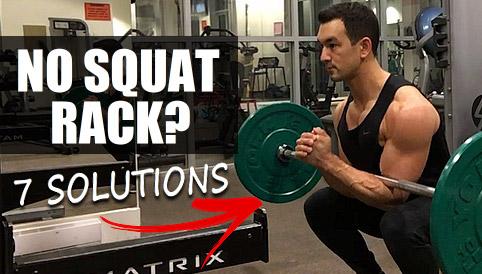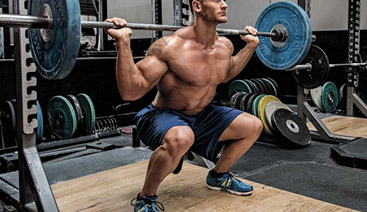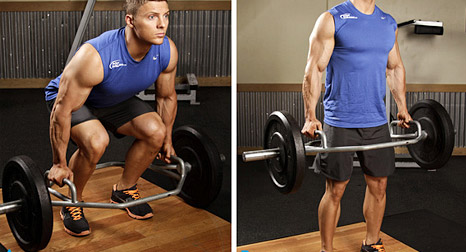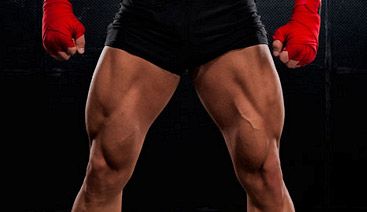NO SQUAT RACK? NO PROBLEM (7 BARBELL SQUAT ALTERNATIVES)

Although squats aren’t necessary in order to build your lower body effectively, they are still the most productive exercise overall when it comes to building up your leg size and strength as efficiently as possible.
In other words, if you want to fully maximize your results and are physically capable of performing squats, you should probably be doing them.
But what if you have no squat rack available and aren’t able to do traditional barbell squats due to the lack of equipment?
Perhaps you train from home, or at a very basic gym that doesn’t have one available.
Not to worry – in this post I’ll be going over 7 squat alternatives you can use instead that require nothing more than a basic barbell or set of dumbbells.
7 Effective Barbell Squat Alternatives

Before diving into the list of exercises below, one question to ask yourself first is whether or not you’ve truly exhausted your options when it comes to setting up your own squat rack.
Don’t just give up on it straight away; do some research first and see if it’s feasible for you to purchase a basic rack of some kind (you can go with something very simple and/or look for used options if cost is an issue) or even put together your own homemade squat rack.
All you really need is some sort of sturdy apparatus that lets you safely unrack and re-rack a loaded bar, and to where you can drop the bar off of your back if you were to get stuck during the exercise.
I personally trained from home during my first couple years of lifting, and ended up using several different “creative solutions” for squatting when I was quite young and didn’t have a rack available.
For example, positioning two saw horses side by side and simply resting the bar across it.
I even went as far as training outdoors and using two large rocks in my backyard as a makeshift squat rack when nothing else was available.
In any case, if you’re serious about fully optimizing your muscle building results, I’d suggest putting in some effort first to see if you can find a solution for performing barbell squats from home either by purchasing a rack or building one somehow.
If you really have no way of doing this, then one of the 6 squat variations outlined below can be used instead.
#1 – Bulgarian Split Squat
The Bulgarian split squat is a highly underrated lower body movement that will really fire up your quads when executed properly.
It might feel a bit awkward at first and does require some practice, but if you have no squat rack available then this would probably be my top recommended barbell squat alternative.
Some data has even shown that split squats are equally as effective as barbell squats when it comes to lower body strength development. (1)
To perform them, hold a pair of dumbbells at your sides and use a staggered stance with one foot up on the bench behind you (toe pointing down) and the other foot forward.
From there, begin lowering yourself down by flexing the knee and hip of your front leg until your rear knee is just short of touching the ground.
Once you reach the bottom position, press yourself back up until your front knee is just short of being locked out.
#2 – Zercher Squats
This is a squat variation you’ll almost never see being performed in the gym, but it’s actually quite effective at hitting the quads and glutes and can be used as a barbell squat alternative.
Rather than placing the bar across your upper back as you would with a regular squat, what you’ll do instead is hold the bar in front of your body inside the crook of your elbows.
It might look easy, but Zercher squats are actually quite a challenging exercise to perform.
That’s because in addition to training your lower body, they also bring your upper back, biceps and shoulders into play since you’ll have to hold the weight in place throughout the entire set.
Zercher squats are ideally done inside of a squat rack, but they can still be performed without one by sumo deadlifting the bar off the floor, resting it on your thighs and then hooking your arms underneath.
Once you’re in position, simply perform a regular squat as usual.
This will also be an awkward movement at first, so make sure to practice with light weights to get the proper form down before increasing the load.
#3 – Power Clean Into Front Squat
Front squats are a great alternative to regular barbell back squats and train the lower body very effectively with the added bonus of placing less stress on the lower back.
Because of the bar position (held in front of your body rather than resting on your upper back) you won’t be able to handle as much weight and can overload your quads sufficiently while using lighter loads.
For that reason, if you have the overall strength and technical skill to do so, one option for those who don’t have a squat rack available is to simply clean the bar straight off the floor and right into a front squat.
Proper power clean form involves many small technical details that are beyond the scope of this article, but for a very brief and simplified explanation you can check out this video. If you’ve never done these before, start off very light and practice them before adding more weight.
Once you’ve gotten the bar into position, simply perform a regular front squat by placing the bar across the front of your shoulders with your elbows positioned forward as high as possible and fingers under the bar on each side.
Feet should be spaced about shoulder-width apart with your toes pointing slightly outward.
Keep your head up, and while maintaining a tight upper back and flat lower back, squat down until your thighs are parallel to the floor, and then drive yourself back up.
Once you’ve completed your desired number of reps, you can simply drop the bar back onto the floor.
The amount of weight you can use on this squat variation will obviously be limited by how much you can clean off the floor.
So, if power cleans are a new movement for you, just go with lighter weights and higher rep sets until you’ve built up your overall strength further.
#4 – Pistol Squats
The main upside of pistol squats is that because they’re so challenging to perform, you really don’t need much resistance (if any) to train them with a high level of intensity.
This makes them ideal for home leg workouts if you have no squat rack available, or if you’re traveling and don’t have access to heavier weights.
To perform pistol squats, stand with your feet about hip width apart and raise one foot very slightly off the floor.
Descend down into a squatting position while extending your arms and opposite leg out in front of you until your butt is just short of touching the floor, and then drive yourself back up into the starting position.
Pistol squats involve a significant balance and coordination aspect, and just like the previous barbell squat alternatives we’ve covered, these will also require practice before they begin to feel more natural.
Once you can perform pistol squats with proper form and have built up some decent strength on them, you can increase the resistance by holding a pair of dumbbells at your sides.
#5 – Barbell Hack Squat
Another very uncommon lift, a barbell hack squat is essentially just a regular barbell deadlift except that you’ll be holding the bar behind your body rather than out in front.
At this particular angle, a greater amount of stress will be shifted onto your quads rather than your back, making them a good barbell squat alternative if you have no squat rack handy.
Aside from that one difference, simply perform these the same way you’d do a regular barbell deadlift.
#6 – Goblet Squat
You’ve likely seen these being performed in the gym as they’re a fairly common squat variation.
The basic form is the same as any regular squat, except that you’ll be holding a dumbbell up at chest height with your palms facing upward and elbows tucked in.
You can also perform these with a kettlebell if you prefer.
Depending on how strong you are and how much weight you have access to, you may need to go with higher rep sets to really overload your quads since you’ll only be using a single dumbbell.
In any case, goblet squats are a viable barbell squat alternative either done on their own or in combination with the other exercises we’ve outlined so far.
#7 – Trap Bar Deadlift

While we’re on the subject of deadlifts, another variation that places more emphasis on the lower body as opposed to the back and could technically be used as a squat alternative would be a trap bar deadlift.
If you don’t have the funds to invest in a full squat rack, purchasing a trap bar (also known as a hex bar) is another viable option.
This is basically a hexagon shaped bar that you stand inside of and then grip the handles on the sides as seen above.
This places the line of resistance through the sides of your body rather than out in front, shifting more stress onto the quads and also producing less load on the lower back (here are some other ways you can eliminate lower back pain from deadlifts).
No Squat Rack? No Problem

As you can see, an effective squatting workout is not limited strictly to the traditional barbell back squat.
Even if you don’t have a squat rack available, all it takes is a basic barbell or pair of dumbbells (or even just your body weight alone) and there are a variety of different squat alternatives you can make use of instead.
Try some of these other alternatives to build bigger quads as well.
If you found this article helpful, make sure to sign up for your FREE custom fitness plan below...



